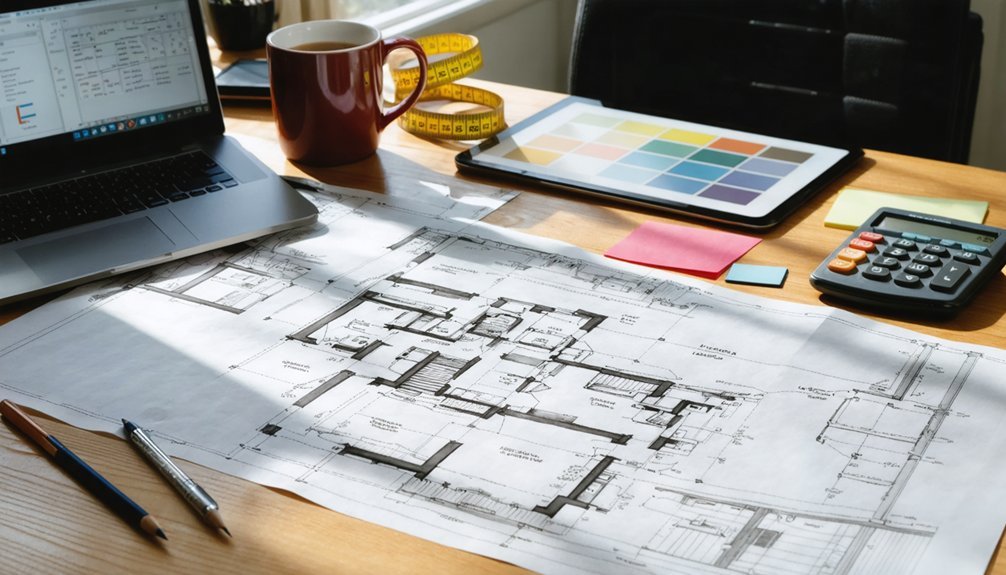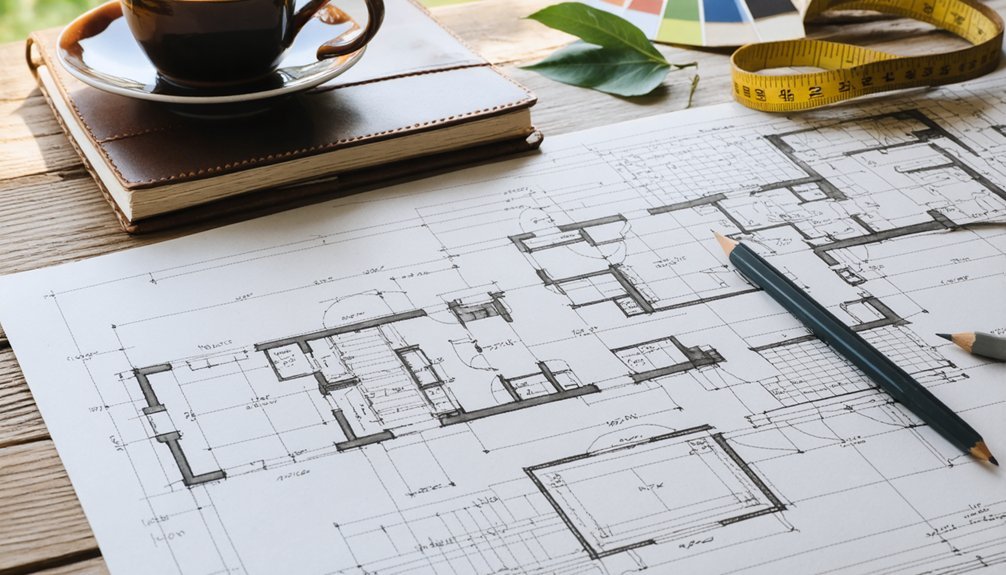Your cart is currently empty!
How to Plan Your Home Renovation in 10 Simple Steps (2025 Guide)

Start your home renovation journey by defining clear goals and creating a realistic budget with a 20% buffer for surprises. Research current design trends and materials while vetting qualified contractors through references and portfolios. Establish a detailed timeline, set up communication channels, and create a digital folder for tracking documents and progress. Don't forget to plan for temporary living arrangements during construction. Follow these expert steps to transform your space with confidence and peace of mind.
Define Your Renovation Goals and Vision

Before diving into any renovation project, you'll need to establish clear goals and create a detailed vision for your home's transformation. Start by identifying what's not working in your current space – whether it's outdated fixtures, poor functionality, or limited storage. Reflect on how you want to use each room and what specific improvements will enhance your daily life.
Write down your must-haves and nice-to-haves, then prioritize them based on importance and budget. Think about your home's style and how your planned changes will complement its existing architecture. Don't forget to contemplate long-term factors like resale value and energy efficiency. Take inspiration from design magazines, social media, and home improvement shows, but make sure your vision aligns with your practical needs and lifestyle.
Set a Realistic Budget and Financial Plan
While dreaming up renovation plans is exciting, establishing a detailed budget is crucial for project success. You'll need to research costs, get multiple contractor quotes, and add a 20% buffer for unexpected expenses. Break down your budget into clear categories and determine if you'll use savings, loans, or both to fund the project.
| Expense Category | Typical % of Budget |
|---|---|
| Labor Costs | 30-35% |
| Materials | 30-35% |
| Fixtures/Finishes | 15-20% |
| Permits/Fees | 5-10% |
| Emergency Buffer | 20% |
Track every expense in a spreadsheet and regularly compare actual costs against your estimates. If you're seeking financing, compare interest rates from multiple lenders and understand their terms. Remember that higher-quality materials may cost more upfront but could save money long-term through increased durability and energy efficiency.
Research Current Design Trends and Materials

Smart renovation planning requires staying current with design trends and material innovations that can enhance your home's value and functionality. Browse design magazines, follow home improvement influencers, and visit showrooms to identify styles that match your aesthetic while maintaining broad appeal.
Pay attention to sustainable materials, energy-efficient options, and smart home technology that'll add long-term value. You'll want to research both trending finishes like matte black fixtures or large-format tiles, and timeless elements that won't quickly become dated. Consider durability ratings, maintenance requirements, and real-world reviews of materials you're interested in using.
Create a digital mood board of your favorite design elements and material choices. This visual guide will help you communicate your vision to contractors and guarantee cohesive style throughout your renovation.
Create a Detailed Project Timeline
A well-structured timeline serves as the backbone of any successful renovation project. You'll need to break down your renovation into distinct phases, considering the logical sequence of tasks and potential dependencies. Start by working backward from your desired completion date, factoring in realistic timeframes for each stage of work.
Key phases to include in your timeline:
- Pre-construction (2-3 weeks): Finalizing designs, obtaining permits, and selecting contractors
- Demolition and structural work (1-2 weeks): Removing old fixtures, walls, and preparing the space
- Major installations (3-4 weeks): Plumbing, electrical, flooring, and cabinetry
Remember to build in buffer time for unexpected delays, material delivery times, and contractor availability. Keep your timeline flexible but structured, and communicate it clearly with all involved parties to guarantee everyone stays aligned with project goals.
Choose and Vet Professional Contractors

With your timeline established, selecting the right contractors becomes your next major step. Start by gathering recommendations from friends, family, and online review platforms. Create a shortlist of at least three contractors and request detailed bids from each.
When vetting contractors, verify their licenses, insurance coverage, and professional certifications. Don't hesitate to ask for references from recent clients and photos of completed projects. Schedule face-to-face meetings to discuss your renovation plans and assess their communication style and professionalism.
Pay attention to red flags like unusually low bids, pressure tactics, or reluctance to provide documentation. Once you've chosen a contractor, make certain all project details, including materials, costs, and timelines, are clearly outlined in a written contract before work begins.
Obtain Necessary Permits and Approvals
Before breaking ground on your renovation project, securing the proper permits and approvals from local authorities is essential. Contact your city's building department to learn which permits you'll need and what documentation they require. While smaller cosmetic changes might not need permits, most structural, electrical, or plumbing work will require official approval.
- Picture yourself facing hefty fines and having to redo completed work because you skipped the permit process
- Imagine discovering your insurance won't cover damage because you didn't obtain proper permits
- Visualize the struggle of selling your home later when buyers discover unpermitted renovations
Don't rely solely on your contractor to handle permits – you're ultimately responsible for compliance. Schedule inspections at key project phases and keep all documentation in a dedicated folder for future reference.
Develop a Room-by-Room Action Plan

Once you've secured permits, creating a detailed room-by-room action plan will keep your renovation organized and efficient. Start by listing every space you'll renovate and break down each room's requirements into specific tasks. Include details like demolition, electrical work, plumbing, flooring, painting, and fixtures.
Prioritize rooms based on both functionality and budget constraints. Consider which spaces need immediate attention and which can wait. You'll want to tackle bathrooms and kitchens first if they're essential to daily living. Map out the sequence of work to minimize disruption and avoid damaging completed areas. Create a timeline for each room, factoring in material delivery dates, contractor availability, and drying times. Don't forget to plan temporary living arrangements if you'll need to relocate during specific phases.
Plan for Temporary Living Arrangements
Since major renovations can disrupt daily routines, you'll need to create a livable temporary space during construction. Consider whether you'll stay in your home or relocate temporarily based on the renovation's scope and duration. If you're staying, set up a functional living area away from the construction zone with essential items and appliances.
- Create a makeshift kitchen in your garage with a microwave, mini-fridge, and portable cooktop
- Set up a cozy bedroom in your finished basement or home office with proper ventilation and privacy curtains
- Designate a clean bathroom that won't be affected by construction dust and debris
If you decide to move out, factor temporary housing costs into your budget and research short-term rentals, extended-stay hotels, or staying with family members. Don't forget to arrange secure storage for furniture and valuables during the renovation.
Establish a Communication Strategy

Having a temporary living arrangement in place sets the stage for the next key element: clear communication channels with your renovation team. You'll need to establish specific methods for staying updated and addressing concerns throughout the project.
| Communication Method | Purpose |
|---|---|
| Weekly Site Meetings | Review progress and discuss upcoming work phases |
| Group Chat App | Quick updates and daily communication |
| Shared Cloud Drive | Store documents, permits, and design files |
| Emergency Contact List | Handle urgent issues or after-hours problems |
Set up these channels before construction begins and make certain everyone knows their preferred contact methods. You'll want to designate a primary point of contact for both your household and the contractor's team. This prevents miscommunication and guarantees you're always in the loop about your renovation's progress.
Document and Track Project Progress
While your renovation team handles the physical work, maintaining detailed records of the project's evolution is equally essential. Create a digital folder to store photos, receipts, contracts, and change orders. Take daily progress photos and maintain a project journal to document key decisions, challenges, and solutions.
Use a project management app or spreadsheet to track:
- Completed milestones – from demolition and framing to electrical work and finishing touches
- Budget updates – including approved changes, unexpected costs, and remaining funds
- Timeline adjustments – noting weather delays, material deliveries, and inspection schedules
Keep all communication records with contractors, designers, and suppliers in one place. This documentation will prove invaluable for future reference, warranty claims, and potential resale value discussions.
Conclusion
By following these 10 steps, you'll transform your renovation from an intimidating project into a manageable, well-organized endeavor. Remember to stay flexible as unexpected challenges may arise. Keep your goals, budget, and timeline in focus while maintaining clear communication with your contractors. When you plan thoroughly and stay organized, you'll be better equipped to create the home of your dreams.
Leave a Reply